Reference and inference in English reading and implications in vietnamese language classrooms
Abstract: This study employed a quasi-experimental design in which guided strategies and practice
exercises were integrated into the curriculum to measure effects of the treatment in improving students’
referring and inferring ability. Besides, a descriptive study based on questionnaire, pre and post -
reading tests was designed to complement the experimental study and to investigate the factors causing
their difficulties in answering these types of questions in English. Results indicate that students’
insufficient knowledge of the language, their inexperience in answering the questions, their teachers’
neglect of the questions, and the absence of the questions in the course books are the four causes of
their struggling. Also, students’ referring and inferring ability can be developed by teacher’s adapting
certain reading tasks in the course book.
Keywords: English reading ability, difficulty, inference, reference
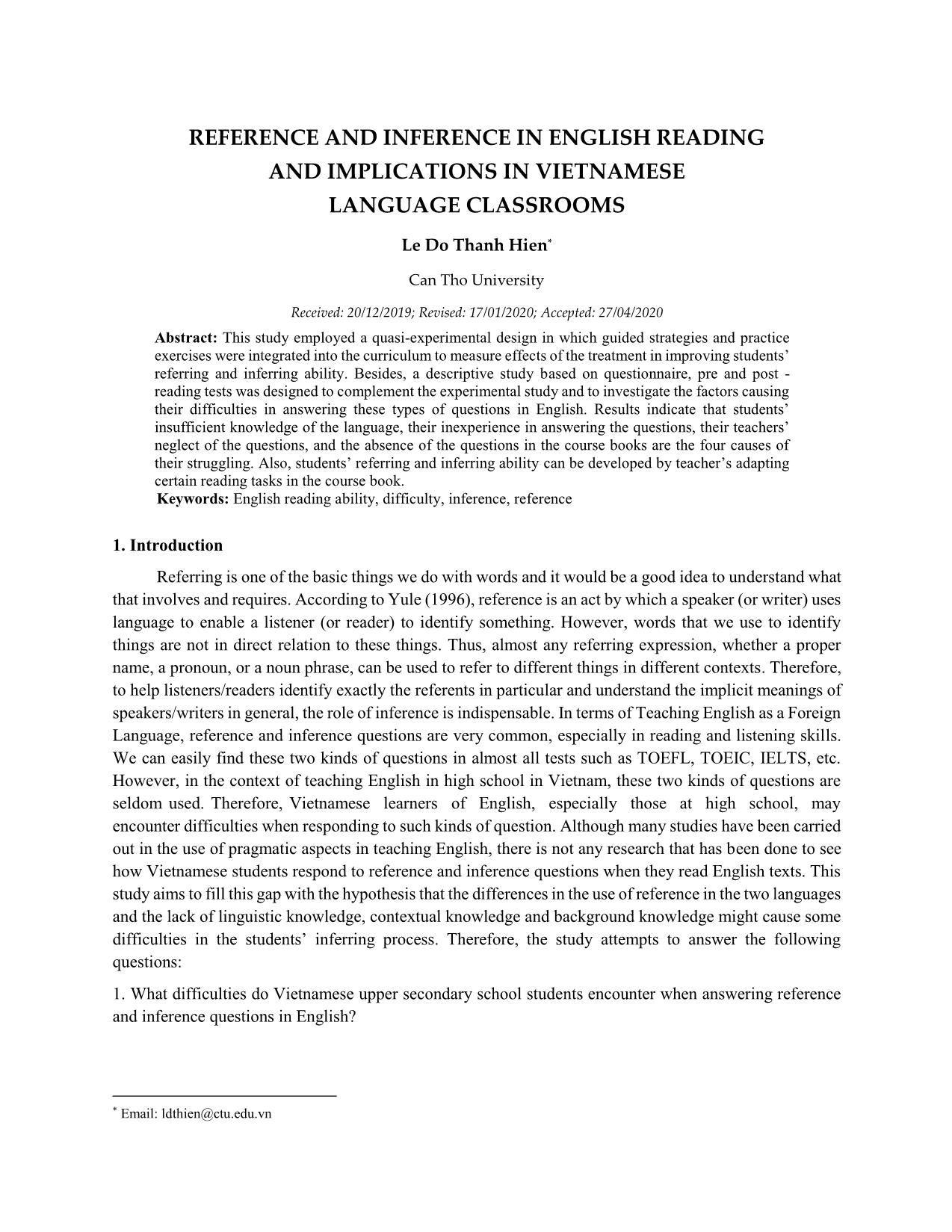
Trang 1
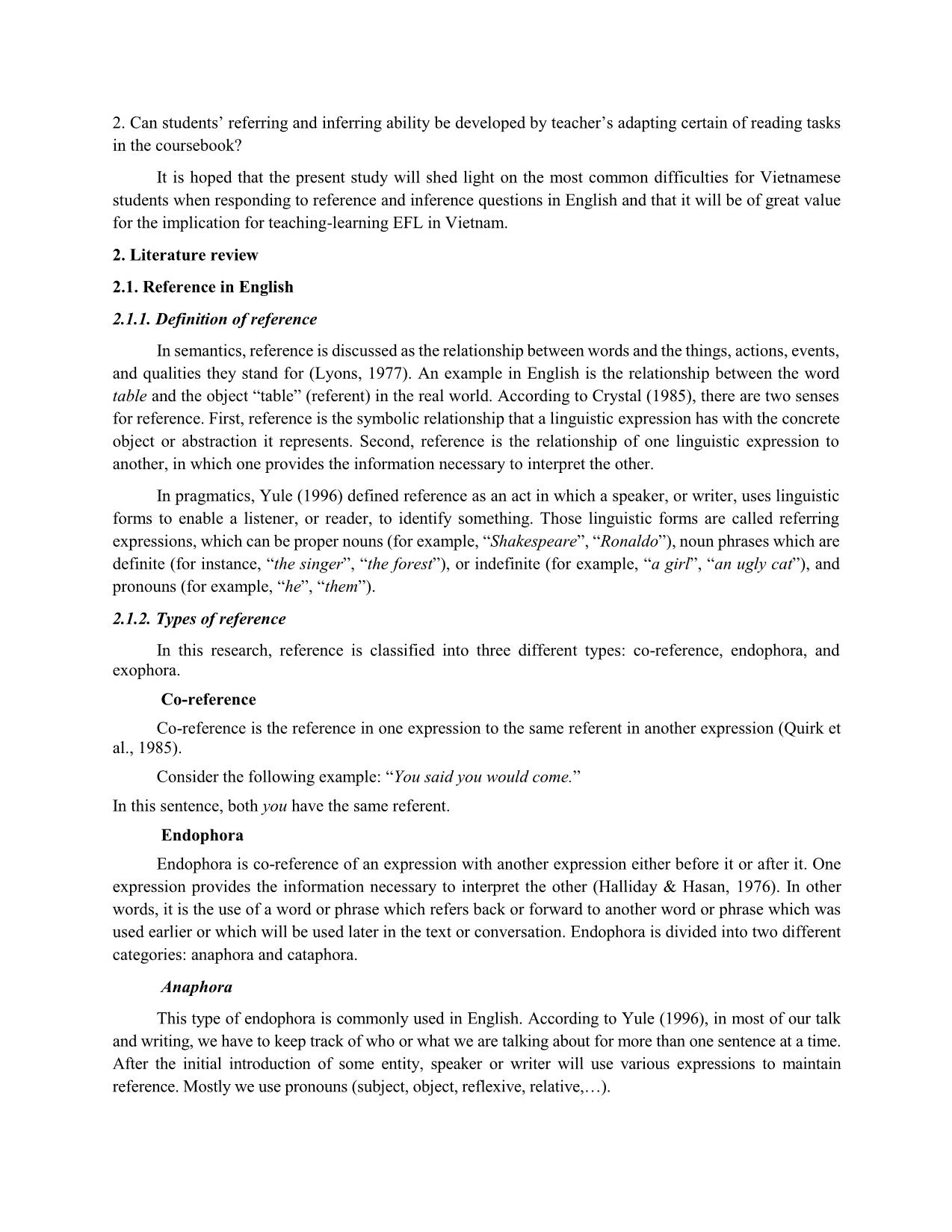
Trang 2
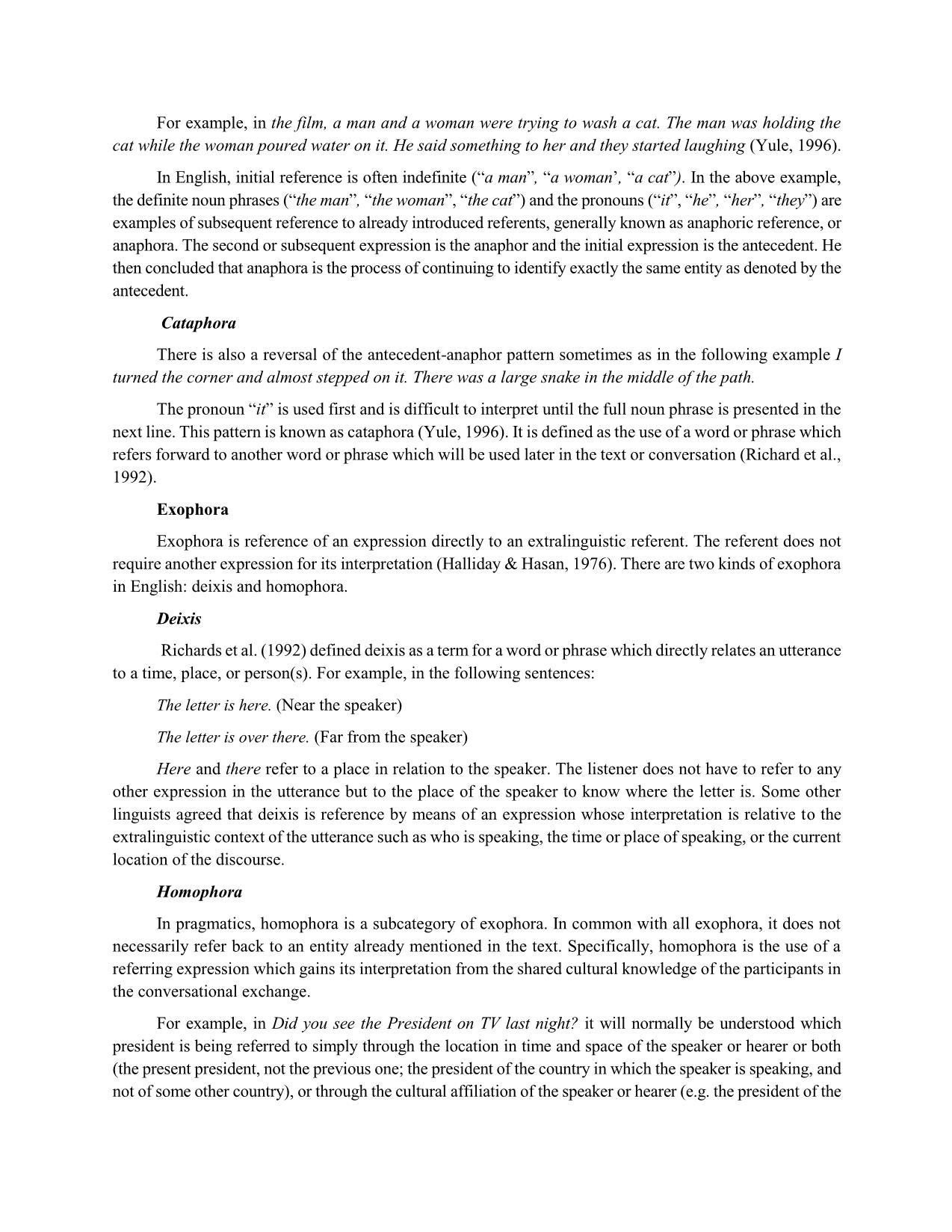
Trang 3
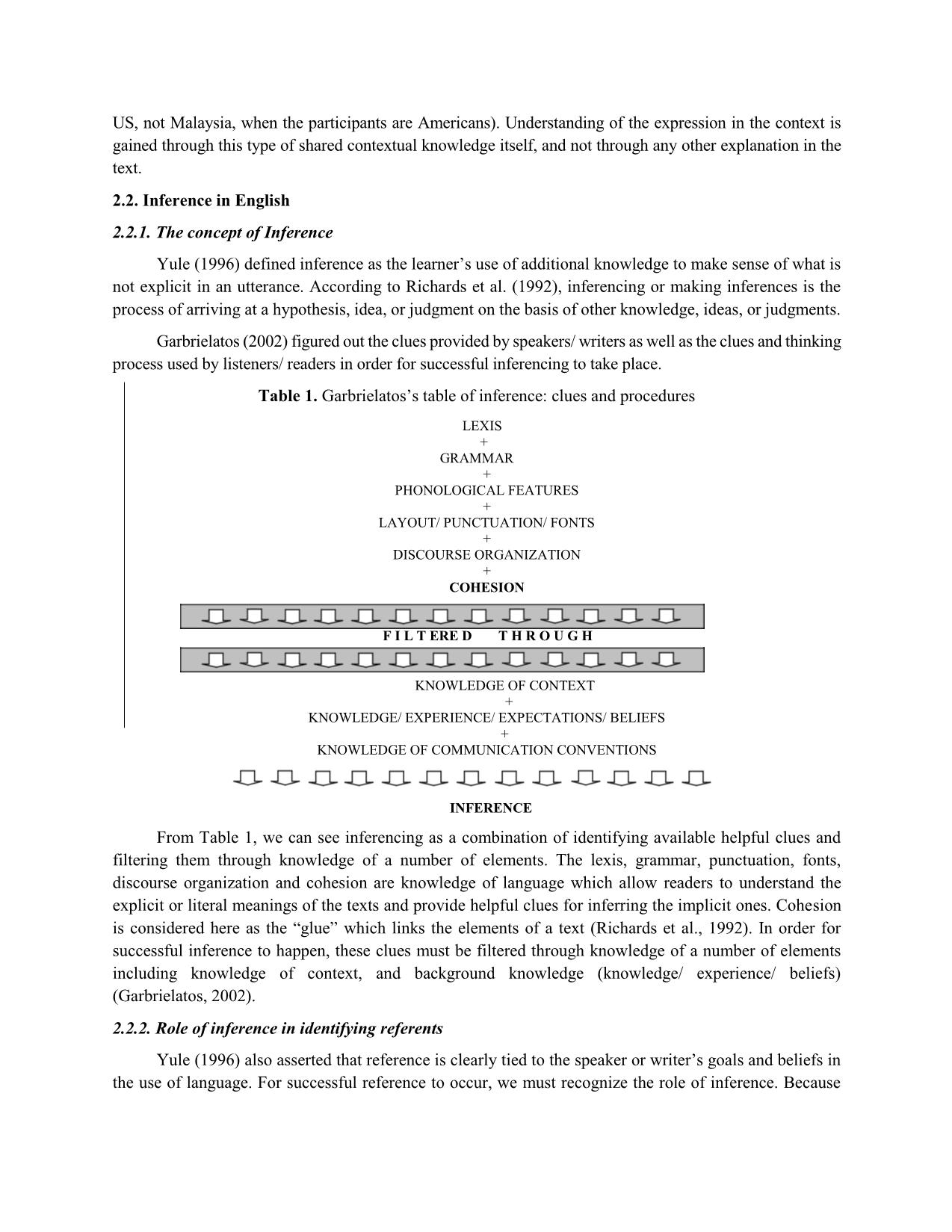
Trang 4
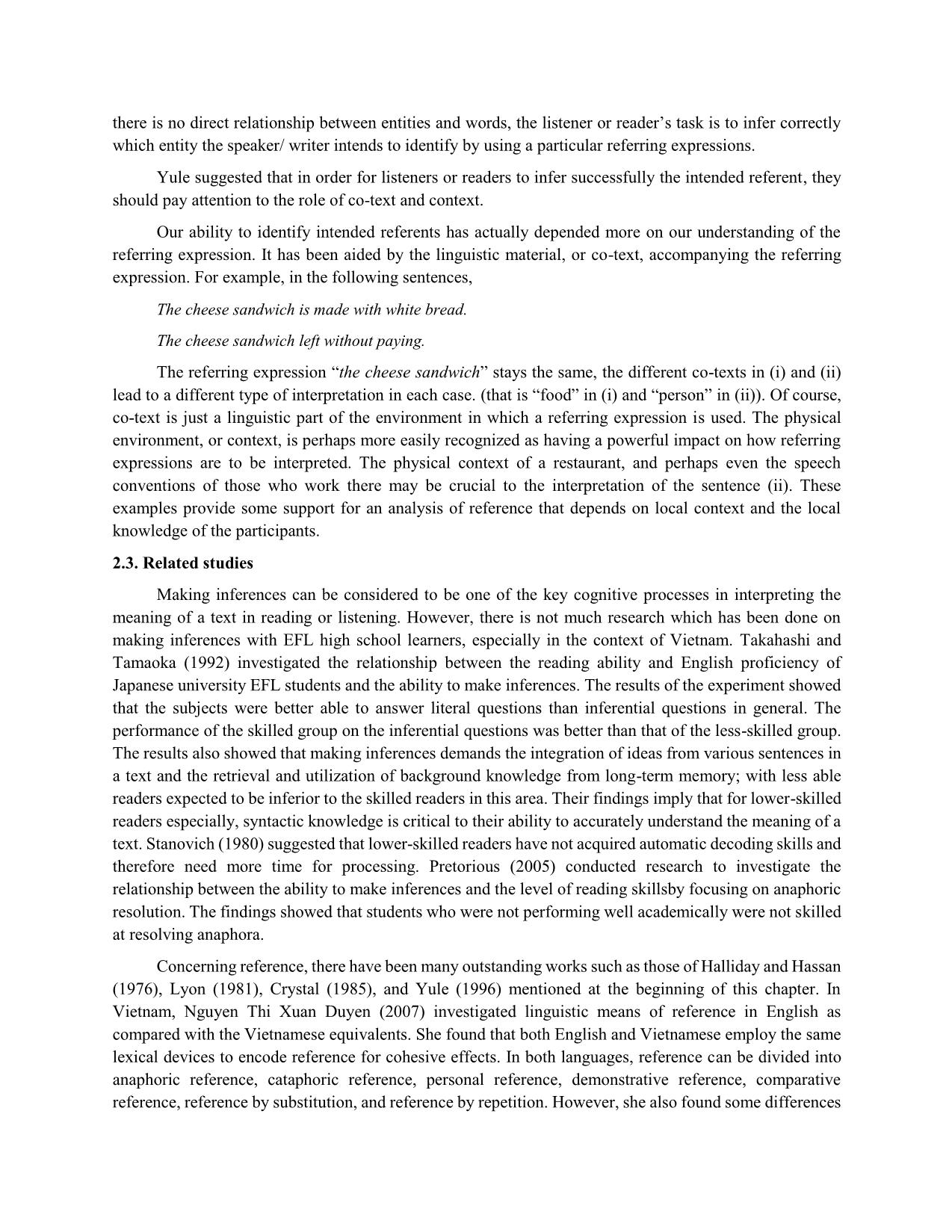
Trang 5
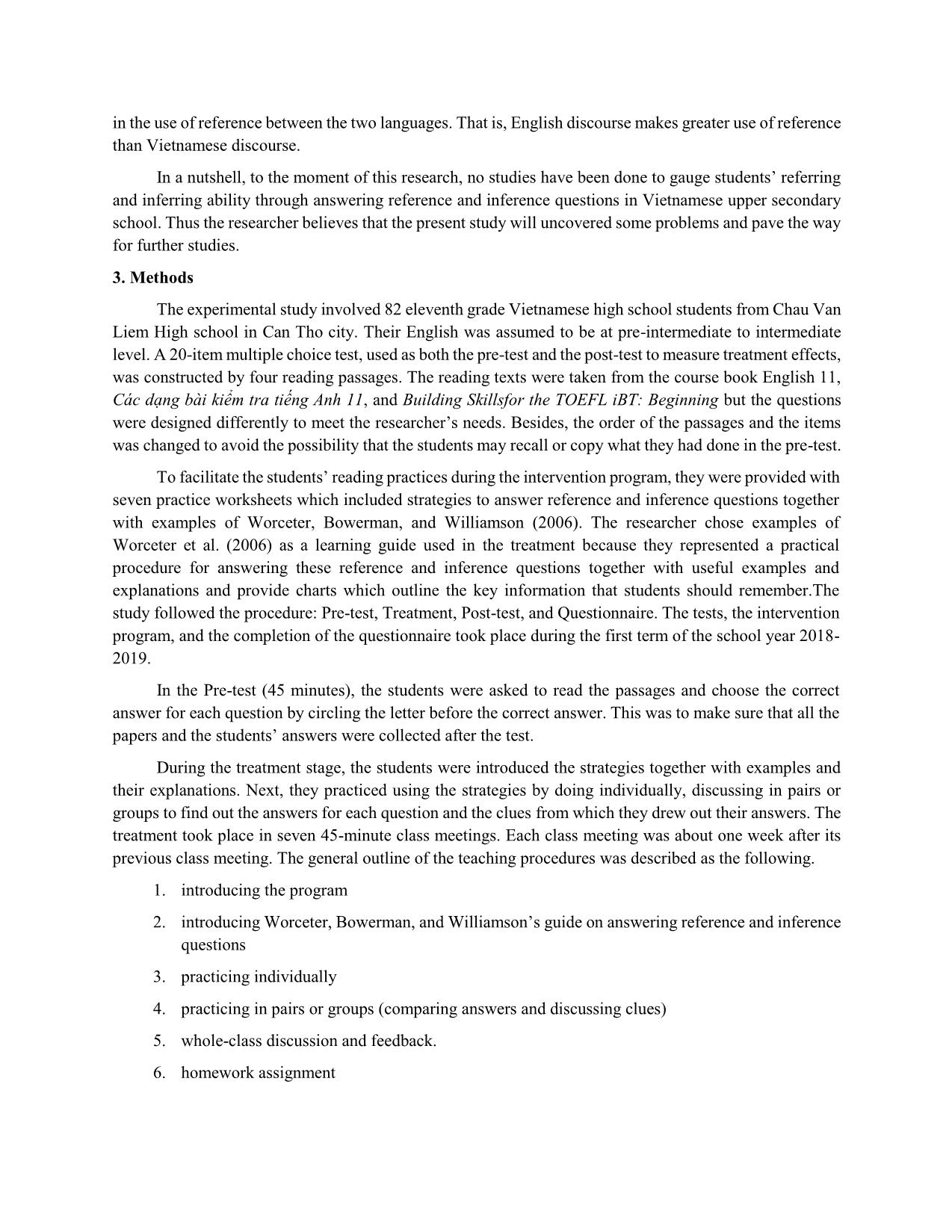
Trang 6
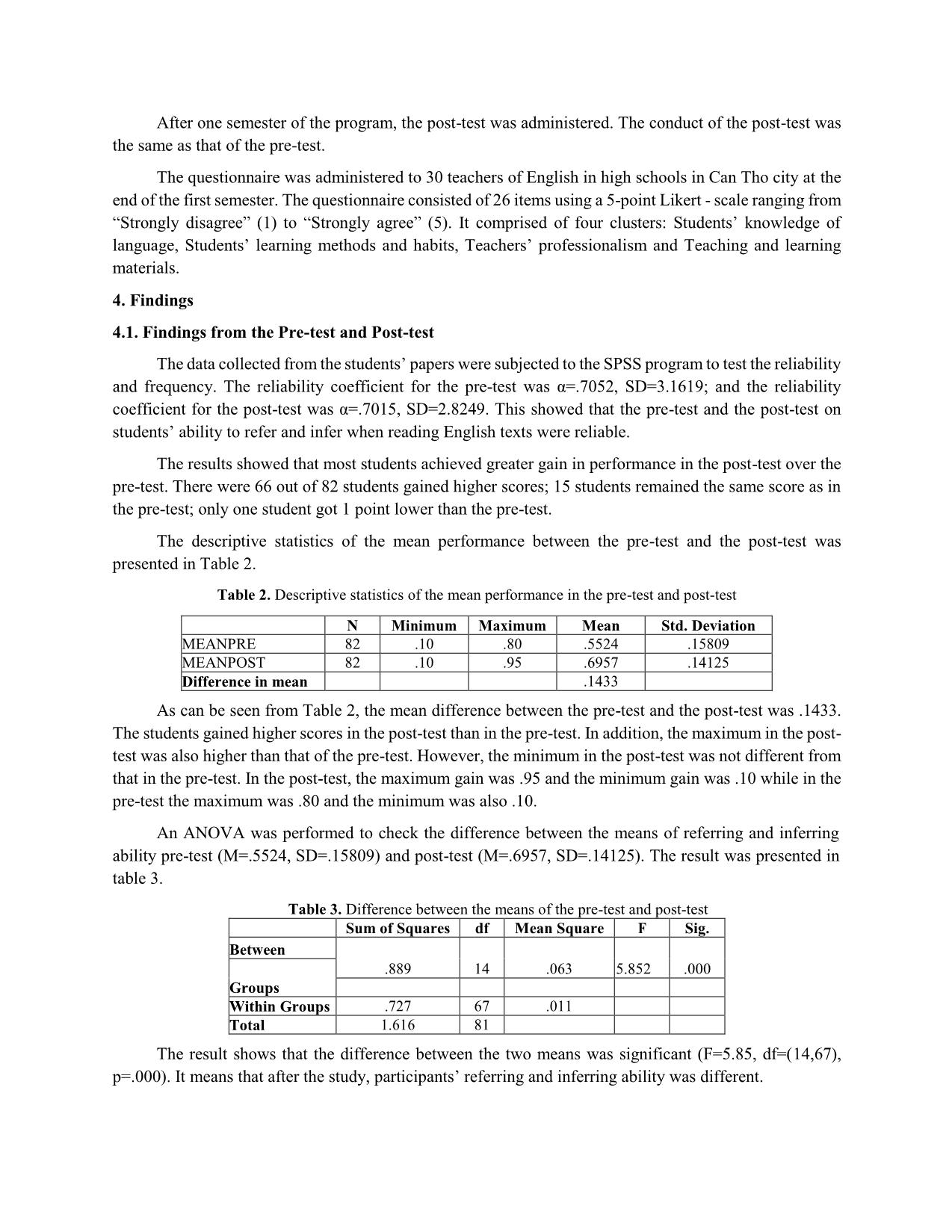
Trang 7
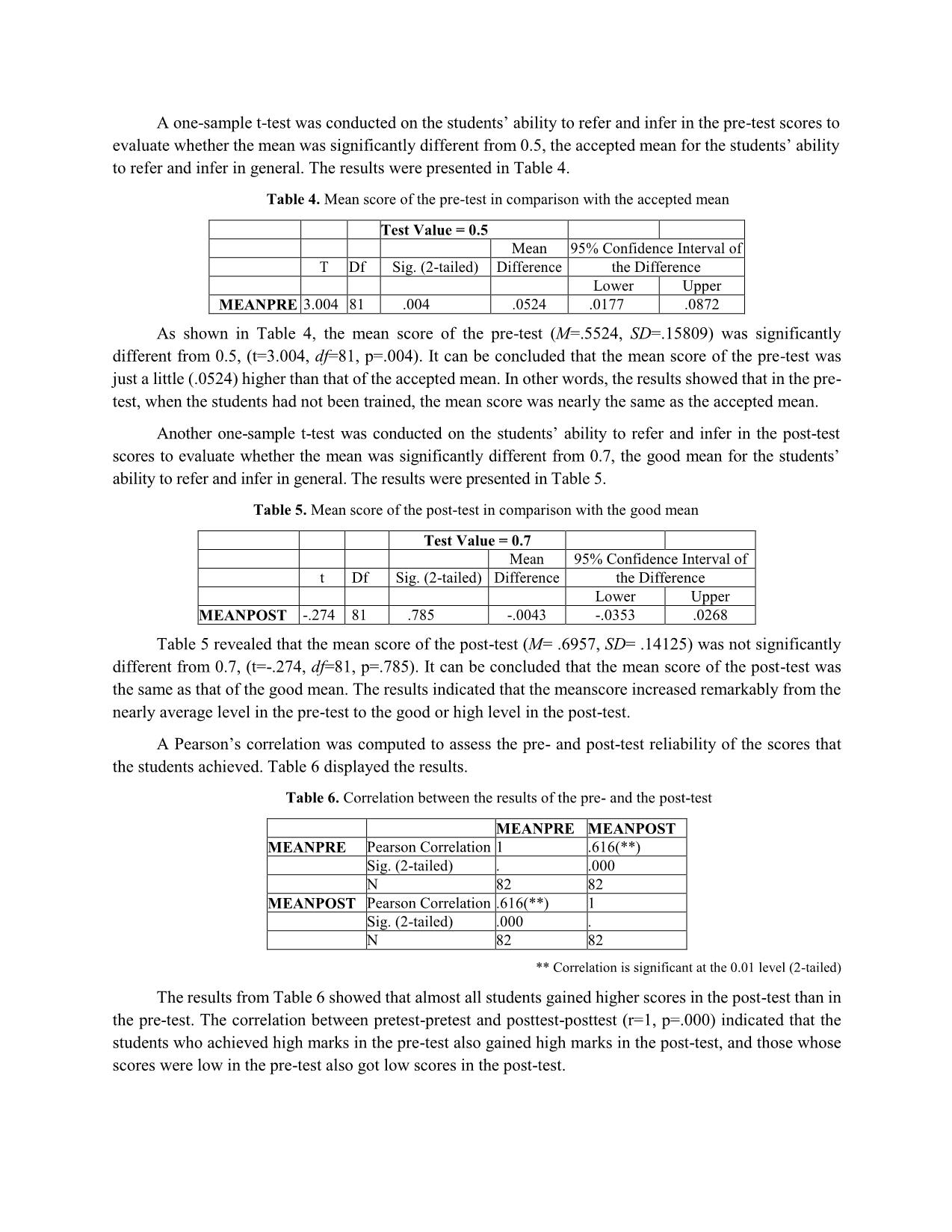
Trang 8
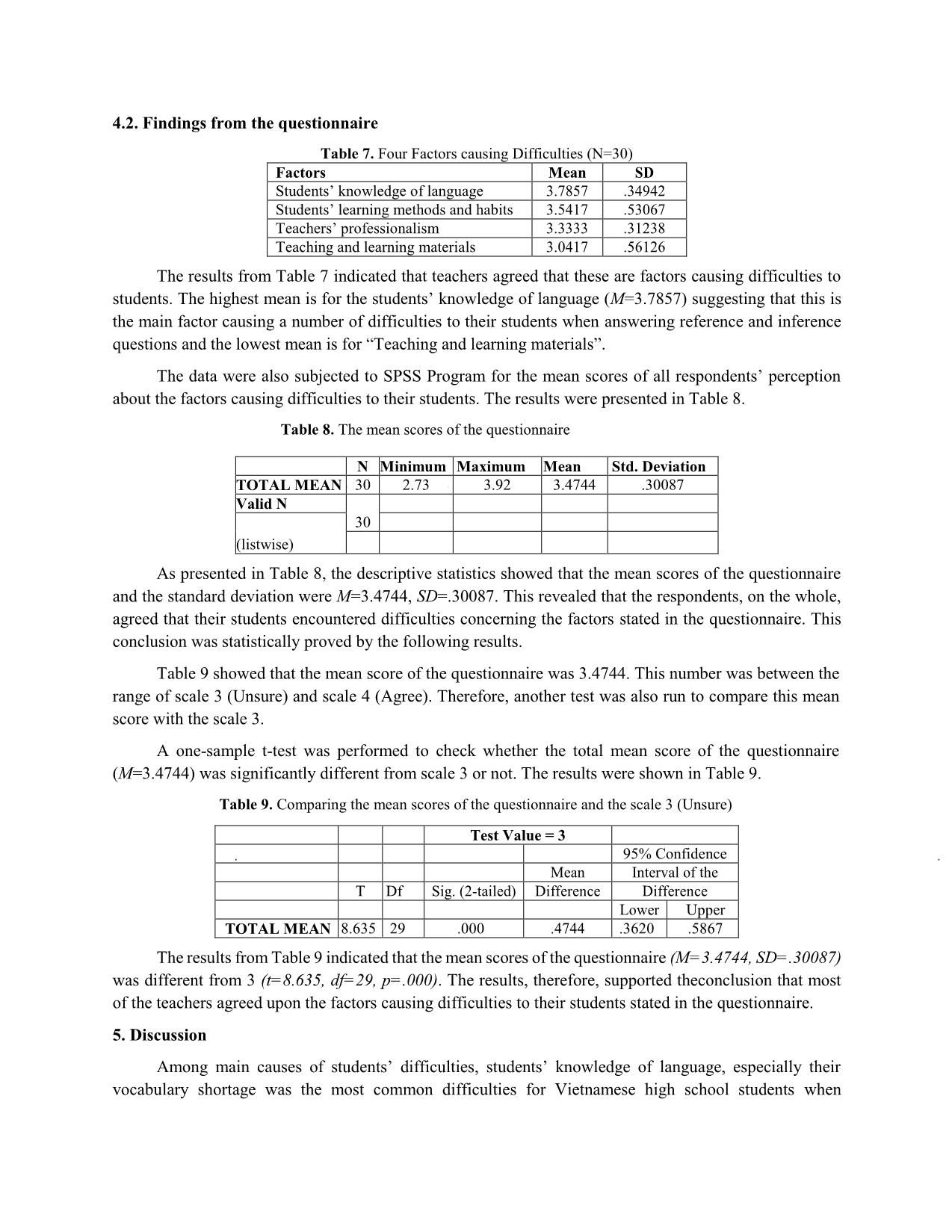
Trang 9
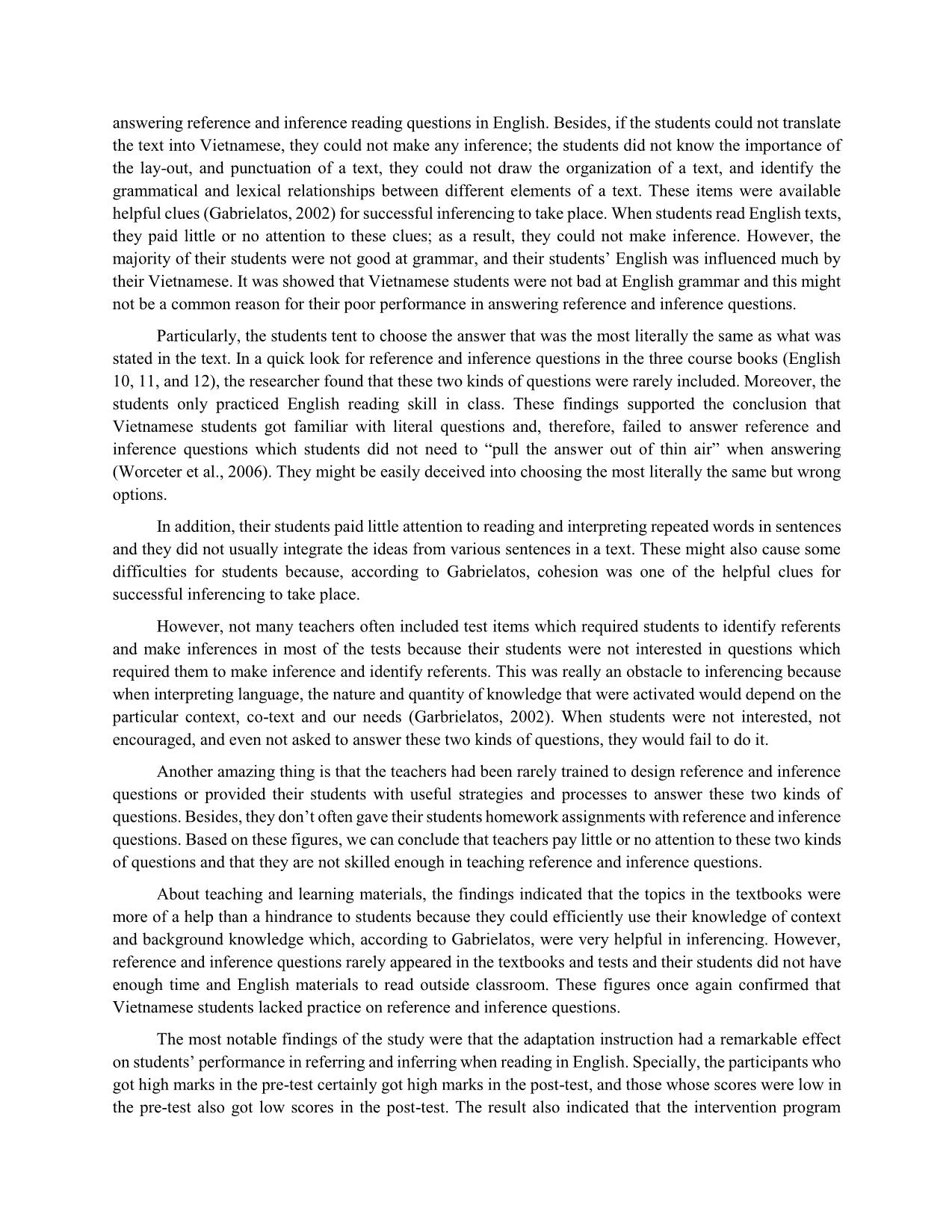
Trang 10
Tải về để xem bản đầy đủ
Tóm tắt nội dung tài liệu: Reference and inference in English reading and implications in vietnamese language classrooms
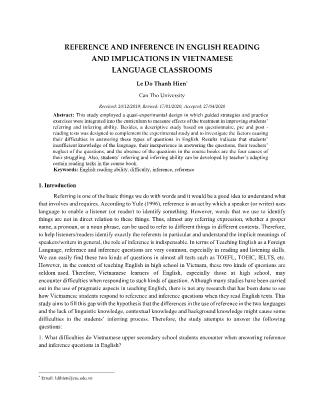
REFERENCE AND INFERENCE IN ENGLISH READING AND IMPLICATIONS IN VIETNAMESE LANGUAGE CLASSROOMS Le Do Thanh Hien* Can Tho University Received: 20/12/2019; Revised: 17/01/2020; Accepted: 27/04/2020 Abstract: This study employed a quasi-experimental design in which guided strategies and practice exercises were integrated into the curriculum to measure effects of the treatment in improving students’ referring and inferring ability. Besides, a descriptive study based on questionnaire, pre and post - reading tests was designed to complement the experimental study and to investigate the factors causing their difficulties in answering these types of questions in English. Results indicate that students’ insufficient knowledge of the language, their inexperience in answering the questions, their teachers’ neglect of the questions, and the absence of the questions in the course books are the four causes of their struggling. Also, students’ referring and inferring ability can be developed by teacher’s adapting certain reading tasks in the course book. Keywords: English reading ability, difficulty, inference, reference 1. Introduction Referring is one of the basic things we do with words and it would be a good idea to understand what that involves and requires. According to Yule (1996), reference is an act by which a speaker (or writer) uses language to enable a listener (or reader) to identify something. However, words that we use to identify things are not in direct relation to these things. Thus, almost any referring expression, whether a proper name, a pronoun, or a noun phrase, can be used to refer to different things in different contexts. Therefore, to help listeners/readers identify exactly the referents in particular and understand the implicit meanings of speakers/writers in general, the role of inference is indispensable. In terms of Teaching English as a Foreign Language, reference and inference questions are very common, especially in reading and listening skills. We can easily find these two kinds of questions in almost all tests such as TOEFL, TOEIC, IELTS, etc. However, in the context of teaching English in high school in Vietnam, these two kinds of questions are seldom used. Therefore, Vietnamese learners of English, especially those at high school, may encounter difficulties when responding to such kinds of question. Although many studies have been carried out in the use of pragmatic aspects in teaching English, there is not any research that has been done to see how Vietnamese students respond to reference and inference questions when they read English texts. This study aims to fill this gap with the hypothesis that the differences in the use of reference in the two languages and the lack of linguistic knowledge, contextual knowledge and background knowledge might cause some difficulties in the students’ inferring process. Therefore, the study attempts to answer the following questions: 1. What difficulties do Vietnamese upper secondary school students encounter when answering reference and inference questions in English? * Email: ldthien@ctu.edu.vn 2. Can students’ referring and inferring ability be developed by teacher’s adapting certain of reading tasks in the coursebook? It is hoped that the present study will shed light on the most common difficulties for Vietnamese students when responding to reference and inference questions in English and that it will be of great value for the implication for teaching-learning EFL in Vietnam. 2. Literature review 2.1. Reference in English 2.1.1. Definition of reference In semantics, reference is discussed as the relationship between words and the things, actions, events, and qualities they stand for (Lyons, 1977). An example in English is the relationship between the word table and the object “table” (referent) in the real world. According to Crystal (1985), there are two senses for reference. First, reference is the symbolic relationship that a linguistic expression has with the concrete object or abstraction it represents. Second, reference is the relationship of one linguistic expression to another, in which one provides the information necessary to interpret the other. In pragmatics, Yule (1996) defined reference as an act in which a speaker, or writer, uses linguistic forms to enable a listener, or reader, to identify something. Those linguistic forms are called referring expressions, which can be proper nouns (for example, “Shakespeare”, “Ronaldo”), noun phrases which are definite (for instance, “the singer”, “the forest”), or indefinite (for example, “a girl”, “an ugly cat”), and pronouns (for example, “he”, “them”). 2.1.2. Types of reference In this research, reference is classified into three different types: co-reference, endophora, and exophora. Co-reference Co-reference is the reference in one expression to the same referent in ... one-sample t-test was conducted on the students’ ability to refer and infer in the pre-test scores to evaluate whether the mean was significantly different from 0.5, the accepted mean for the students’ ability to refer and infer in general. The results were presented in Table 4. Table 4. Mean score of the pre-test in comparison with the accepted mean Test Value = 0.5 Mean 95% Confidence Interval of T Df Sig. (2-tailed) Difference the Difference Lower Upper MEANPRE 3.004 81 .004 .0524 .0177 .0872 As shown in Table 4, the mean score of the pre-test (M=.5524, SD=.15809) was significantly different from 0.5, (t=3.004, df=81, p=.004). It can be concluded that the mean score of the pre-test was just a little (.0524) higher than that of the accepted mean. In other words, the results showed that in the pre- test, when the students had not been trained, the mean score was nearly the same as the accepted mean. Another one-sample t-test was conducted on the students’ ability to refer and infer in the post-test scores to evaluate whether the mean was significantly different from 0.7, the good mean for the students’ ability to refer and infer in general. The results were presented in Table 5. Table 5. Mean score of the post-test in comparison with the good mean Test Value = 0.7 Mean 95% Confidence Interval of t Df Sig. (2-tailed) Difference the Difference Lower Upper MEANPOST -.274 81 .785 -.0043 -.0353 .0268 Table 5 revealed that the mean score of the post-test (M= .6957, SD= .14125) was not significantly different from 0.7, (t=-.274, df=81, p=.785). It can be concluded that the mean score of the post-test was the same as that of the good mean. The results indicated that the meanscore increased remarkably from the nearly average level in the pre-test to the good or high level in the post-test. A Pearson’s correlation was computed to assess the pre- and post-test reliability of the scores that the students achieved. Table 6 displayed the results. Table 6. Correlation between the results of the pre- and the post-test MEANPRE MEANPOST MEANPRE Pearson Correlation 1 .616(**) Sig. (2-tailed) . .000 N 82 82 MEANPOST Pearson Correlation .616(**) 1 Sig. (2-tailed) .000 . N 82 82 ** Correlation is significant at the 0.01 level (2-tailed) The results from Table 6 showed that almost all students gained higher scores in the post-test than in the pre-test. The correlation between pretest-pretest and posttest-posttest (r=1, p=.000) indicated that the students who achieved high marks in the pre-test also gained high marks in the post-test, and those whose scores were low in the pre-test also got low scores in the post-test. 4.2. Findings from the questionnaire Table 7. Four Factors causing Difficulties (N=30) Factors Mean SD Students’ knowledge of language 3.7857 .34942 Students’ learning methods and habits 3.5417 .53067 Teachers’ professionalism 3.3333 .31238 Teaching and learning materials 3.0417 .56126 The results from Table 7 indicated that teachers agreed that these are factors causing difficulties to students. The highest mean is for the students’ knowledge of language (M=3.7857) suggesting that this is the main factor causing a number of difficulties to their students when answering reference and inference questions and the lowest mean is for “Teaching and learning materials”. The data were also subjected to SPSS Program for the mean scores of all respondents’ perception about the factors causing difficulties to their students. The results were presented in Table 8. Table 8. The mean scores of the questionnaire N Minimum Maximum Mean Std. Deviation TOTAL MEAN 30 2.73 3.92 3.4744 .30087 Valid N 30 (listwise) As presented in Table 8, the descriptive statistics showed that the mean scores of the questionnaire and the standard deviation were M=3.4744, SD=.30087. This revealed that the respondents, on the whole, agreed that their students encountered difficulties concerning the factors stated in the questionnaire. This conclusion was statistically proved by the following results. Table 9 showed that the mean score of the questionnaire was 3.4744. This number was between the range of scale 3 (Unsure) and scale 4 (Agree). Therefore, another test was also run to compare this mean score with the scale 3. A one-sample t-test was performed to check whether the total mean score of the questionnaire (M=3.4744) was significantly different from scale 3 or not. The results were shown in Table 9. Table 9. Comparing the mean scores of the questionnaire and the scale 3 (Unsure) Test Value = 3 95% Confidence Mean Interval of the T Df Sig. (2-tailed) Difference Difference Lower Upper TOTAL MEAN 8.635 29 .000 .4744 .3620 .5867 The results from Table 9 indicated that the mean scores of the questionnaire (M=3.4744, SD=.30087) was different from 3 (t=8.635, df=29, p=.000). The results, therefore, supported theconclusion that most of the teachers agreed upon the factors causing difficulties to their students stated in the questionnaire. 5. Discussion Among main causes of students’ difficulties, students’ knowledge of language, especially their vocabulary shortage was the most common difficulties for Vietnamese high school students when answering reference and inference reading questions in English. Besides, if the students could not translate the text into Vietnamese, they could not make any inference; the students did not know the importance of the lay-out, and punctuation of a text, they could not draw the organization of a text, and identify the grammatical and lexical relationships between different elements of a text. These items were available helpful clues (Gabrielatos, 2002) for successful inferencing to take place. When students read English texts, they paid little or no attention to these clues; as a result, they could not make inference. However, the majority of their students were not good at grammar, and their students’ English was influenced much by their Vietnamese. It was showed that Vietnamese students were not bad at English grammar and this might not be a common reason for their poor performance in answering reference and inference questions. Particularly, the students tent to choose the answer that was the most literally the same as what was stated in the text. In a quick look for reference and inference questions in the three course books (English 10, 11, and 12), the researcher found that these two kinds of questions were rarely included. Moreover, the students only practiced English reading skill in class. These findings supported the conclusion that Vietnamese students got familiar with literal questions and, therefore, failed to answer reference and inference questions which students did not need to “pull the answer out of thin air” when answering (Worceter et al., 2006). They might be easily deceived into choosing the most literally the same but wrong options. In addition, their students paid little attention to reading and interpreting repeated words in sentences and they did not usually integrate the ideas from various sentences in a text. These might also cause some difficulties for students because, according to Gabrielatos, cohesion was one of the helpful clues for successful inferencing to take place. However, not many teachers often included test items which required students to identify referents and make inferences in most of the tests because their students were not interested in questions which required them to make inference and identify referents. This was really an obstacle to inferencing because when interpreting language, the nature and quantity of knowledge that were activated would depend on the particular context, co-text and our needs (Garbrielatos, 2002). When students were not interested, not encouraged, and even not asked to answer these two kinds of questions, they would fail to do it. Another amazing thing is that the teachers had been rarely trained to design reference and inference questions or provided their students with useful strategies and processes to answer these two kinds of questions. Besides, they don’t often gave their students homework assignments with reference and inference questions. Based on these figures, we can conclude that teachers pay little or no attention to these two kinds of questions and that they are not skilled enough in teaching reference and inference questions. About teaching and learning materials, the findings indicated that the topics in the textbooks were more of a help than a hindrance to students because they could efficiently use their knowledge of context and background knowledge which, according to Gabrielatos, were very helpful in inferencing. However, reference and inference questions rarely appeared in the textbooks and tests and their students did not have enough time and English materials to read outside classroom. These figures once again confirmed that Vietnamese students lacked practice on reference and inference questions. The most notable findings of the study were that the adaptation instruction had a remarkable effect on students’ performance in referring and inferring when reading in English. Specially, the participants who got high marks in the pre-test certainly got high marks in the post-test, and those whose scores were low in the pre-test also got low scores in the post-test. The result also indicated that the intervention program benefited a certain group of participants. Lower-skilled readers encountered more difficulties with inferential questions and improving their inferring ability than skilled ones. This result was also supported by Stanovich (1980), which suggested that lower-skilled readers had not acquired automatic decoding skills and therefore needed more time for processing. The finding of the present study was also similar to that of Takahashi & Tamaoka (1992), which showed that the performance of the skilled group on the inferential questions was better than that of the less-skilled group and that less able readers were inferior to the skilled readers in this area demanding the integration of ideas from varioussentences in a text and the retrieval and utilization of background knowledge from long-term memory. 6. Conclusion The study aimed to investigate common factors that cause difficulties for Vietnamese high school students when answering reference and inference reading questions in English and whether students’ referring and inferring ability can be developed by teacher’s adapting certain of reading tasks in the course books. On the evidence provided, it can be concluded that Vietnamese high school students face some difficulties mostly due to their poor knowledge of the language, their inexperience in answering the questions, their teachers’ neglect of the questions, and the absence of the questions in the course books. However, students’ referring and inferring ability can be developed by teacher’s adapting certain of reading tasks in the course books. From the findings of the present study, some implications can be set up to high school teachers of English in Vietnam in the field of teaching reading, particularly, teaching reference and inference questions. Firstly, reference and inference questions should be included in the course books (English 10, 11, 12 as well as tests and national examinations like the General Certificate of Highschool Education examination. By doing this, referring and inferring ability will become a must to develop and, therefore, teachers and students will pay much more attention to it. Also, when designing reference questions teachers should cover common types of reference and vary them in different units. Since there are so many types of reference and each of them is used differently, students may find it hard to identify and need to practice adequately. It is the same for inference questions, teachers need to help students practice inferring by using different kinds of clues, ranging from linguistic to contextual and background knowledge. Hopefully, the results will encourage an extension of research into students’ referring and inferring ability. References Crystal, D. (1985). A dictionary of linguistics and phonetics (2nd edition). New York: Basil Blackwell. Gabrielatos, C. (2002). Inference: Procedures and implications for ELT. The University of Lancaster, Lancaster, The United Kingdom. Retrieved from: Halliday, M.A.K., & Hasan, R. (1976). Cohesion in English. London: Longman. Lyons, J. (1977). Semantics, vol 1, 371, vol 2, 897. Cambridge, England: Cambridge University Press. Lyons, J. (1977). Semantics and grammar II. Semantics, 1(2), 423-466. Doi:10.1017/CBO978051162 06 14.004. Nguyễn Thị Xuân Duyên (2007). Reference as a cohesive device in English and Vietnamese written discourse. Unpublished Master’s Thesis. Phu Yen University. Pretorius, E.J. (2005). What do students do when they read to learn? Lessons from five case studies. South African Journal of Higher Education, 19(4), 790-812. Quirk, R., Greenbaum, S., Leech, G., & Svartvik, J. (1985). A comprehensive grammar of the English language. London: Longman. Richards, J.C., Platt, J., & Platt, H. (1992). Dictionary of language teaching and applied linguistics. London: Longman. Stanovich, K.E. (1980). Toward an interactive-compensatory model of individual differences in the development of reading fluency. Reading Research Quarterly, 16, 32-71. Takahashi, T., & Tamaoka, K. (1992). Descriptive analysis of the performance of two English proficiency groups on inferential and literal questions. Gengo Bunka Kenkyu, 12(1), 1-27. Worceter, A., Bowerman, L., & Williamson, E. (2006). Building skills for the TOEFL iBT: Beginning. Compass Media Inc. Yule, G. (1996). Pragmatics. Oxford University Press. CÂU HỎI VỀ TỪ ĐƯỢC QUY CHIẾU VÀ HÀM Ý TRONG MÔN ĐỌC TIẾNG ANH VÀ ỨNG DỤNG TRONG LỚP HỌC NGÔN NGỮ Ở VIỆT NAM Tóm tắt: Nghiên cứu được triển khai theo hướng ngụy thực nghiệm nhằm tích hợp các chiến thuật đọc và bài tập thực hành vào chương trình học để đo lường tính hiệu quả của việc nâng cao khả năng trả lời dạng câu hỏi về từ quy chiếu và hàm ý của học sinh. Ngoài ra, những tác nhân gây khó khăn trong việc trả lời những dạng câu hỏi tiếng Anh này cũng được miêu tả. Kết quả cho thấy việc thiếu kiến thức ngôn ngữ, thiếu kinh nghiệm trả lời của học sinh, việc giáo viên không chú trọng các dạng câu hỏi này và sự xuất hiện hiếm hoi của chúng trong sách giáo khoa là bốn tác nhân chính. Ngoài ra, năng lực trả lời các dạng câu hỏi này của học sinh có thể được cải thiện thông qua các loại hình bài đọc trong sách. Từ khóa: Năng lực đọc hiểu tiếng Anh, khó khăn, hàm ý, từ quy chiếu
File đính kèm:
 reference_and_inference_in_english_reading_and_implications.pdf
reference_and_inference_in_english_reading_and_implications.pdf

